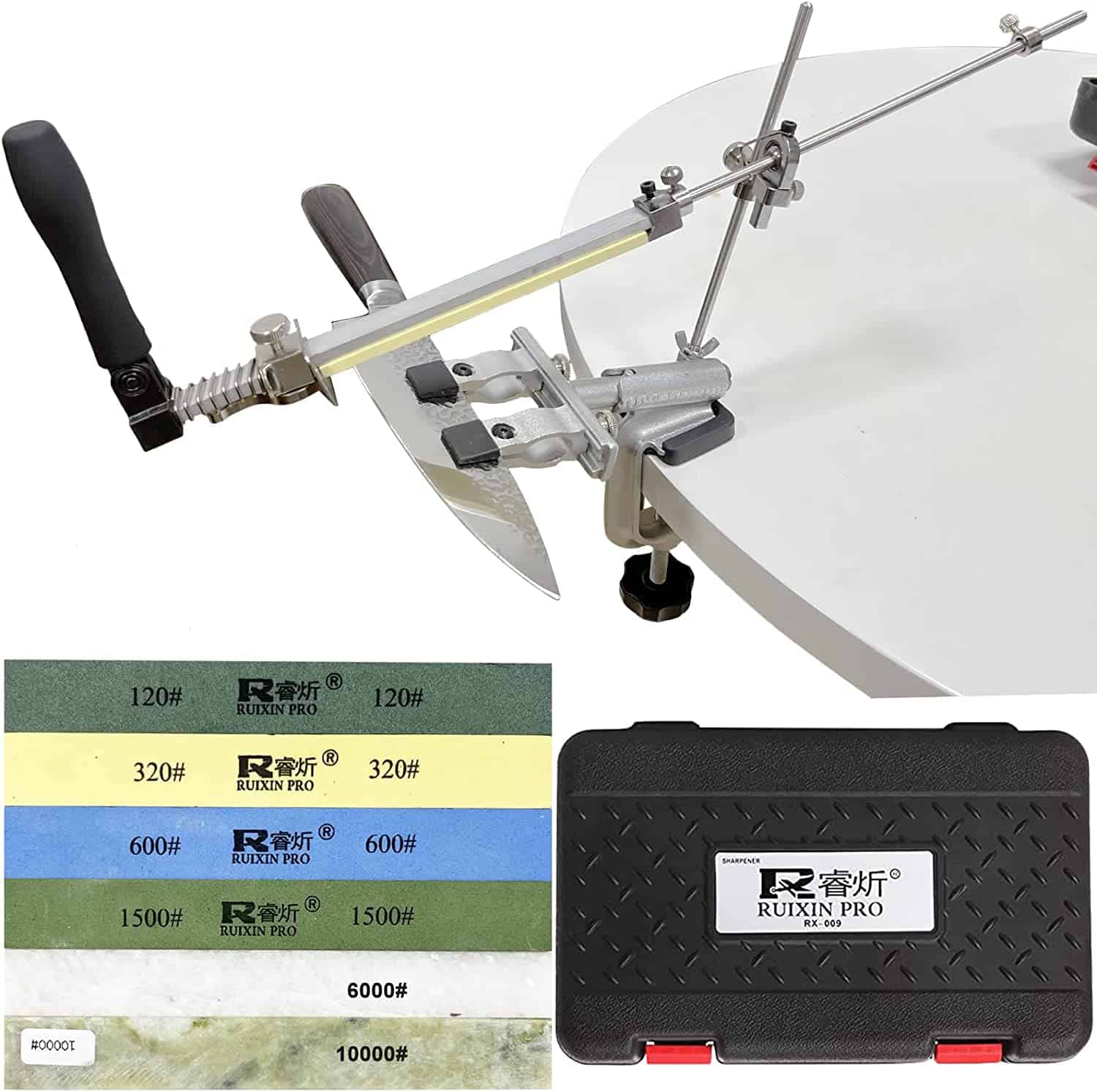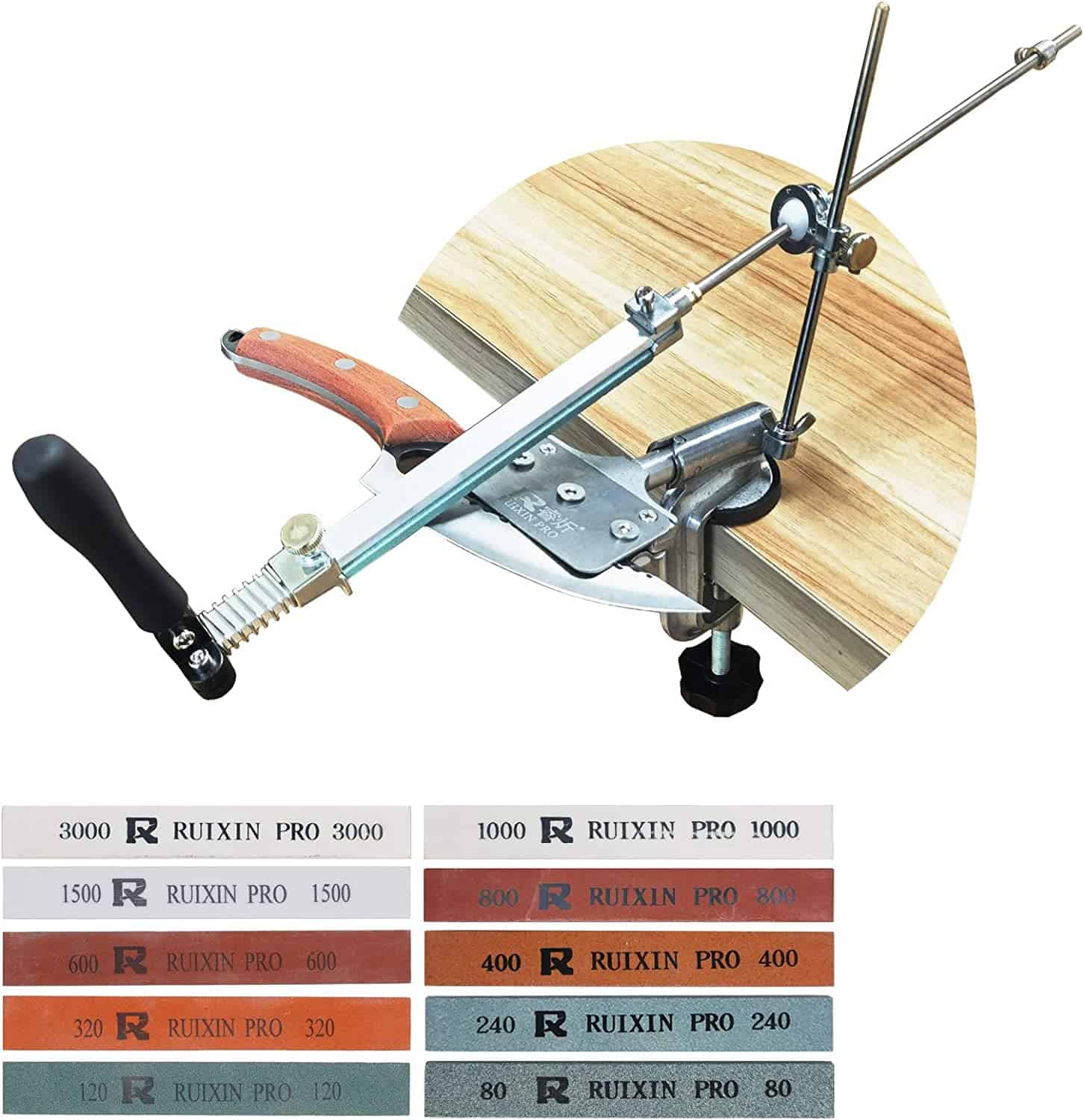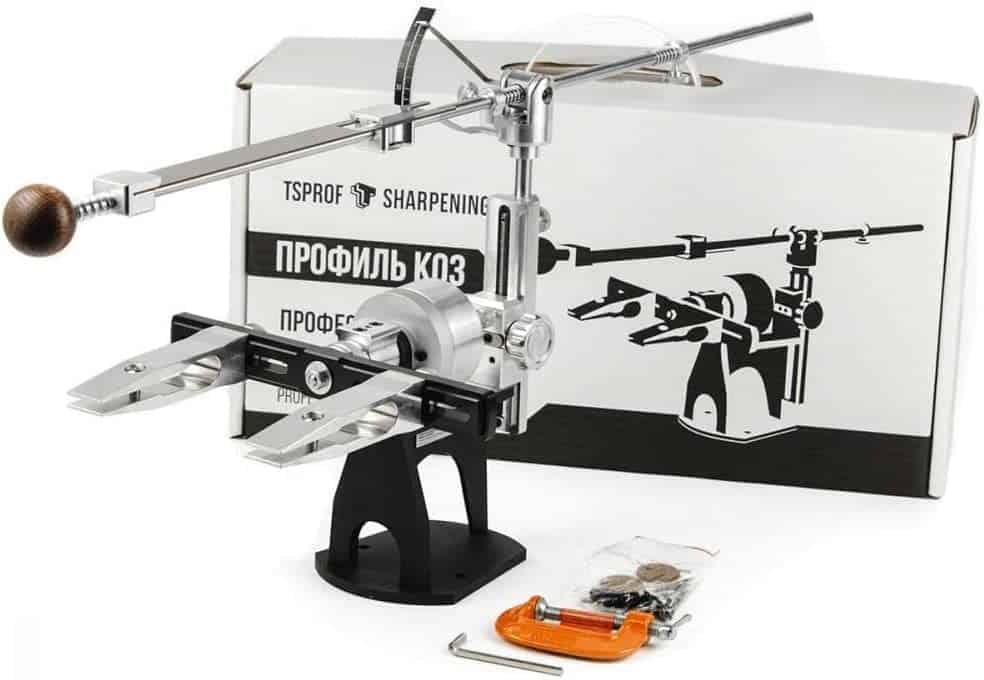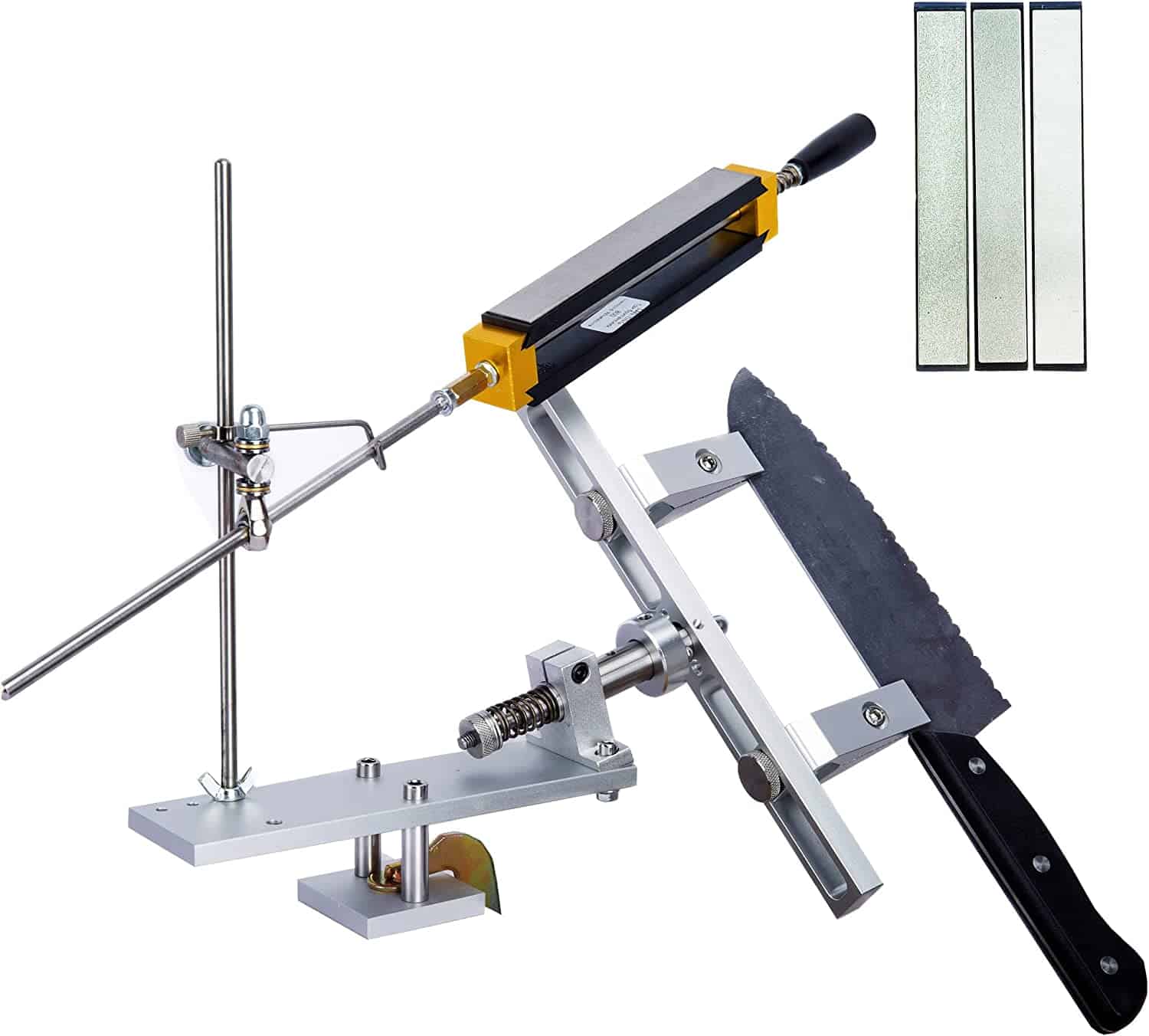Best Sharpening Jigs Reviewed | Keep Your Japanese Knives Sharpened
A collection of Japanese knives requires frequent sharpening because a dull blade won’t make it through a day of cooking without needing to be sharpened.
A sharpening jig allows you to sharpen the blade at a precise angle and this RUIXIN PRO RX-009 Sharpener System is one of the best with a comfortable, ergonomic grip for easy control of the angle of the blade. Plus it has a non-slip rubber base for extra security.
In this guide, I’ll compare the best knife-sharpening jig systems like the Ruixin, TSPROF, and Sytools and talk about what to look for when purchasing one.
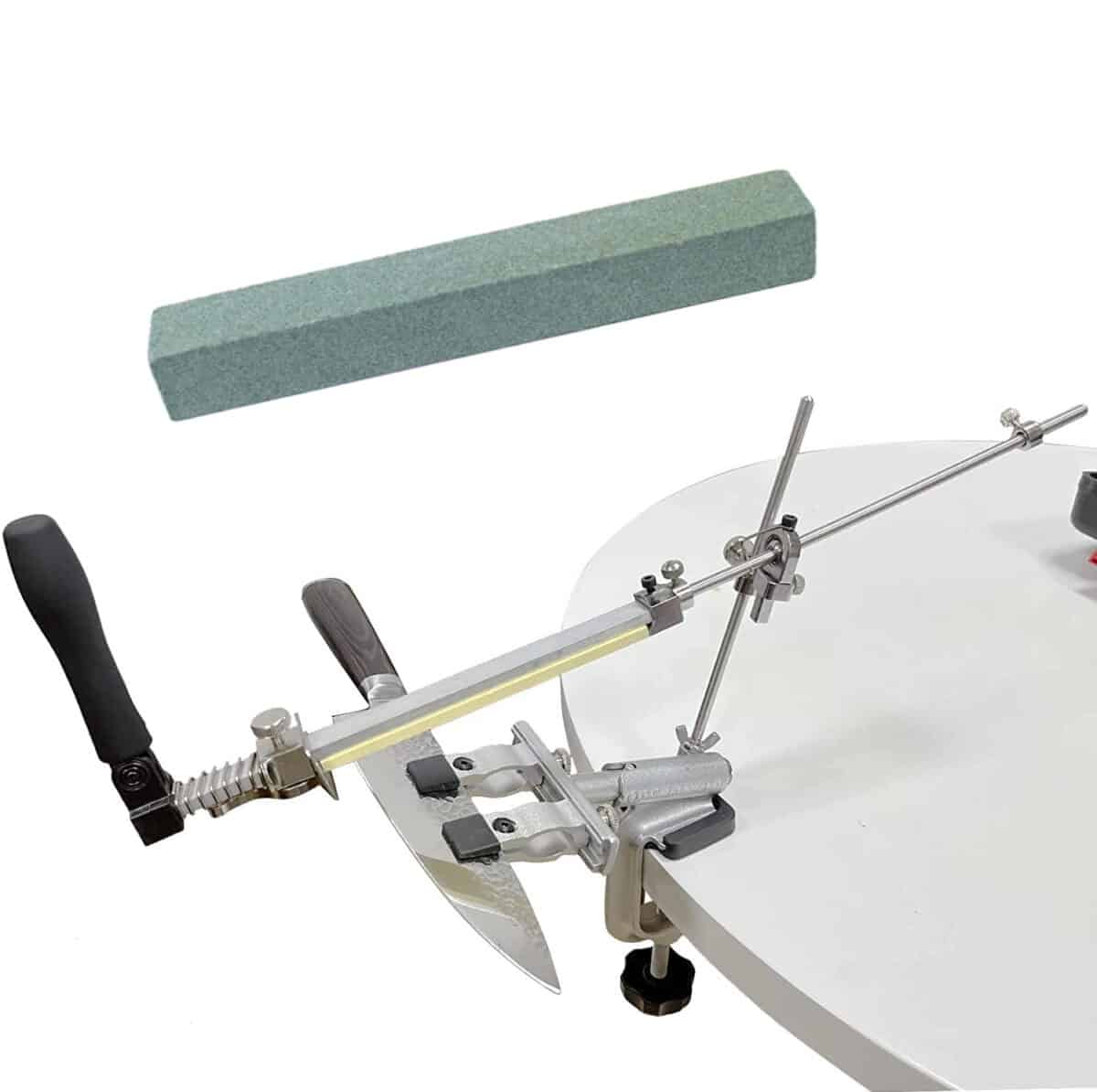
We’ll assess each of the jigs in terms of design, ease of use, performance, and value for money.
Best overall sharpening jig
The RUIXIN 009 is the best choice for sharpening Japanese knives as well as Western knives and easy to work with.
Best cheap sharpening jig
The RUIXIN PRO 008 is a fine alternative to the pricy jigs and your best bet if you’re looking for a cheap sharpener.
Best sharpening jig for professionals
The TSPROF К03 Expert is a great sharpening jig for professionals with an extended range of Sharpening Angle and Edge Profile options.
Best sharpening jig for long blade knives
The Sytools K6 system is a great choice because you can get consistent angle results when sharpening long blades.

Check out our new cookbook
Bitemybun's family recipes with complete meal planner and recipe guide.
Try it out for free with Kindle Unlimited:
Read for freeIn this post we'll cover:
- 1 Buying guide
- 2 Best sharpening jigs reviewed
- 3 FAQ
- 3.1 What is a Japanese sharpening jig?
- 3.2 What are the benefits of using a jig for sharpening Japanese knives?
- 3.3 How to use a sharpening jig
- 3.4 What type of jig is best for sharpening Japanese knives?
- 3.5 How often should a jig be used for sharpening Japanese knives?
- 3.6 What type of stones should be used with a jig for sharpening Japanese knives?
- 3.7 How much time does it take to sharpen a Japanese knife with a jig?
- 3.8 How do you ensure consistent sharpening results when using a jig?
- 3.9 What are the safety precautions to take when sharpening Japanese knives with a jig?
- 4 Takeaway
Buying guide
Home cooks often ask, are there any special considerations to make when choosing a jig for sharpening Japanese knives?
Yes, there are. Sharpening stones and angles vary between different jig systems, so it’s important to select a system suitable for sharpening your Japanese knives.
There are certain features to look for when buying a sharpening jig for your Japanese knives (or any kitchen knife, actually).
Material
Most jigs are made of metal. For example, the premium TSPROF sharpening jig is made of a high-quality aircraft aluminum.
This type of material is long-lasting and provides a solid base for sharpening.
The cheaper RUIXIN jigs are made out of stainless steel and many plastic parts. This is less high quality than the aluminum jig but still does a very good job.
A sharpening system with too many plastic components won’t be as sturdy and is more likely to break.
Sharpening stones
The type of whetstone you use will depend on the type of knife you’re sharpening.
Coarse stones are used for dull blades that need more metal to be removed, while finer stones are used for sharpening polished edges.
These sharpening systems come with a variety of whetstones – some have up to 10 different stones, but the stones are usually cheap and pretty low quality.
That’s why it’s important to look for a jig that can fit better stones like Edge Pro. Compatibility will ensure your jig is versatile enough to sharpen all types of knives.
Sharpening angle and edge profile
The angle you sharpen the blade at is crucial to ensure a sharp, even edge.
Sharpening jigs come with adjustable angles so you can ensure that the blade is sharpened at the same angle every time.
Edge profile is another important factor. Sharpening jigs come with a variety of edge profiles so you can customize the profile to suit your knife.
This is especially important for Japanese knives as they usually require a specific edge profile for proper performance.
Blade size accommodation
You have to consider, ‘can the jig accommodate a tapered tang?’
Is it possible to lock down one width of a spine and then lock down another section of the same blade if it’s narrower and one or two inches away?
The jig should be able to accommodate multiple sizes and shapes of knife blades. Some Japanese blades are very long, so look for a jig that can handle all sizes.
Flip-rotation design
A flip rotation design means that there is a precise slider hinger that allows you to change the direction of the sharpening stone.
This feature is essential for Japanese knives because they require a specific angle for optimal performance.
Also, the clamp can be rotated without having to take the knife out to switch the side of the blade.
Price
Finally, the price is an important factor to consider when purchasing a sharpening jig.
Sharpening jigs range from affordable to very expensive, so decide on a budget and look for the best jig within your price range.
The jigs used by professional chefs are usually over $500, but these can last a lifetime.
However, a home cook can sharpen a variety of knives with a $50-70 system from RUIXIN or similar brands.
Keep your Japanese knives sharper longer by storing them the right way (stands & storage solutions)
Best sharpening jigs reviewed
Here’s a review of the top sharpening jigs on the market.
RUIXIN PRO RX-009 Kitchen Knife Sharpener System
- flip rotation design
- accommodates wider blades
- sturdy metal bearings
- no angle markings
- poor quality whetstones
The Ruixin Pro RX-009 is an upgraded version of the RX-008 system, and it comes with several improvements, especially when it comes to quality.
This sharpener is no longer flimsy and easy to break because it now has metal bearings and a rubberized G-clamp.
As well, the rod is made of a good stainless steel material, and the screws can easily be screwed and unscrewed to adjust the sharpening angle.
The system is also equipped with a flip-rotation design and adjustable angles.
The system also comes with 6 whetstones of different levels (rough, medium, and fine), so you can customize the sharpness to your liking.
The six sharpening stones that range in grit from 120 to 10000. This makes it suitable for both Japanese and Western knives.
This type of grit range allows you to fix chipped edges and sharpen blunt blades.
With the systems flip fixture mechanism, you can sharpen the other side of the knife while maintaining the exact same angle.
To rapidly change the angle to what you desire, simply loosen the screw on the vertical rod. This ensures that knife blades can be sharpened fast and safely.
I like how easy it is to use – even beginners can get started in minutes.
There are several important upgrades compared to the Ruixin 008:
- The 360° Flip Rotation Fixed-Angled Design comes with a more precise slider hinger which isn’t as flimsy as the one on the 008 version.
- The G-Clamp is more secure and easier to fix and hold in place.
- This sharpener now comes with an adjustable knife clip that can accommodate wider blades. It also has rubber plastic sleeves to protect your blade against scratches.
- The 008 system had many plastic components, whereas this upgraded model has all metal bearings making them stronger.
One of the main complaints about the cheaper RX-008 is that the rod holder can move up and down as you’re sharpening and slow you down.
Ruixin seems to have fixed this issue, and all you need to do is screw and unscrew the rod on the vertical rod to adjust the sharpening angle you need.
My concern with this sharpening jig is that there are no angle markings on the rod so you have to use an angle finder.
You can buy one online and then use it to find the perfect angle when sharpening the blade.
Another point to consider is that this sharpener is too large for sharpening boning knives and petty knives, which require a smaller angle.
But overall, the RUIXIN 009 is the best choice for sharpening Japanese knives because of the ability to set the correct angle, and it’s simple to make smooth push and pull strokes.
- material: stainless steel
- 360-degree flip design
- product dimensions: 20″L x 10″W x 10″H
- adjustable knife-clip design
RUIXIN PRO RX-008 Kitchen Knife Sharpener System
- solid base
- fits most knives
- compatible with Edgepro stones
- easy to set up
- has cheap plastic components
- whetstones are low quality
- might be missing parts
If you’re looking for an affordable sharpening jig with a variety of whetstones, the RUIXIN 008 is the one for you.
The base unit feels rock solid, heavy-duty, and of excellent quality, and the whole system is easy to set up and only takes minutes.
Compared to the RUIXIN 009, this one’s stone holder is pretty good and locks the whetstone in place, so it doesn’t move as you’re sharpening the blade.
The clamp is effective as long as it is bolted on properly but not as easy to secure as the other RUIXIN model. They open wide enough to fit a ⅜ inch spine, so that makes it versatile.
When it comes to the span, it can sharpen blades up to 14 inches, maybe even longer, so it’s a very useful sharpener even if you have long blades.
Finding an angle can be done by zeroing in an angle finder on the blade or clamp and then just measuring the sharpening arm angle.
Some of the parts are made of metal, whereas some are made of plastic, and where the plastic meets metal, it can be cheap and flimsy, especially the plastic handle, which may come loose over time.
Luckily, replacement parts are cheap and easy to find.
The drawback is the whetstones since they’re pretty bad quality. For example, the 3000-grit ones don’t feel as fine as they claim to be.
They also generate a large quantity of slurry when used, and this can be good because it provides constant fresh grit and more grit, potentially speeding up the sharpening process.
The rod holder may move up and down if not screwed on tight – this reflects the low prices of this sharpening jig, but you can do the work easily, and it doesn’t really make a big difference.
There are two limiters at the top and bottom, and those keep the rod holder in place.
This jig is useful because it can also accommodate a tapered tang – this is one thing to look for when buying a sharpening jig.
This clamp is large enough to accommodate the tapered tang and, thus, more versatile than many others.
I also like that you can use diamond stones instead of the supplied whetstones with this jig – some people prefer diamond stones because they offer a sharper edge.
An advantage of using this sharpener is that it fits Edge Pro stones which are superior to the cheap whetstones that come with the product.
My biggest concern though is the poor build quality and the fact that the screws come loose so the rod holder can move up and down.
This can potentially be a bit dangerous so it’s best to keep checking that it stays put.
Overall, the RUIXIN PRO 008 is a fine alternative to the pricy jigs, but it’s not going to blow your socks off with its quality.
This is your best bet if you’re looking for a cheap sharpener.
- material: plastic and stainless steel
- product dimensions: 10.94″L x 5.43″W x 3.74″H
- G-clamp with screws
- flip-rotation design
RUIXIN PRO 009 vs RUIXIN PRO 008 Sharpening Stone
The RUIXIN PRO 009 and the RUIXIN PRO 008 Sharpening Stones have advantages and disadvantages.
The PRO 009 is better built, has a larger clamp capacity, and is easier to set up. It also has better stones, which means you can get that perfect edge profile.
On the other hand, the PRO 008 is cheaper and can accommodate Edge Pro Sharpening Stones. It also has a larger span, allowing you to sharpen blades up to 14 inches.
If you’re looking for an affordable sharpening jig with a variety of whetstones, then the RUIXIN PRO 008 Sharpening Stones is the one for you. It may not be as well built but it gets the job done.
But if you’re serious about sharpening a variety of knives, it’s better to invest in the 009 model because it’s made of metal and doesn’t have all the flimsy plastic components which can loosen over time.
TSPROF К03 Expert Knife Sharpening System
- weighted base adjustable
- rod and angles
- rotary mechanism
- stones not included
- clips for short knives not included
This sharpening jig kit comes in a large wooden crate where all the components are stored safely.
At first glance, the TSProf sharpening system looks a bit complicated to assemble but even though there are many parts, this sharpening jig is easy to put together even if you’re not a professional.
In about 10 minutes, you can set up the jig and start sharpening out of the box.
The Ruixin Pro only takes about 5 minutes, but then again, the quality and ease of use are hard to compare.
But after the first use, you can probably reassemble it again in a couple of minutes because it’s easy to learn.
You can detach the main unit from the base and clamp it to another table – this makes it extremely versatile if you don’t like the base or it’s not the perfect fit.
It may be too short, but since it’s portable, the unit can be mounted on another surface.
The base is weighted and stable if you choose to use it that way. Many people also like to use the clamp to mount the unit to the table without the base.
The best feature of this sharpening jig is that it comes with an extended range of sharpening angles that range from 7° to 35° per side.
You can sharpen an angle of about 9 degrees before the stone sharpening stone starts clipping the knife holder, which means that there’s enough clearance.
It can accommodate a spine size of 0.275″ inches and Sharpening Stones up to 10″ long.
That gives you a wide range of Sharpening Angle and Edge Profile options when sharpening your blades.
You can easily flip the blade back and forth because of the rotary mechanism. The height is adjustable, and there are two knobs that you can twist to adjust the angle of sharpening.
The rod that holds the sharpening stones has stops on both of its sides, and you can also add springs to both sides.
The springs ensure that metal doesn’t run into the edges to cause damage – this type of design detail sets this sharpener apart from the cheaper RUIXIN products.
It’s easy to assemble everything, and even the clamps are simply screwed on by hand, even though a special screwdriver is included.
The clamps also have a longer range of size adjustment that ensures the knife being sharpened is held firmly in place.
A disadvantage is that abrasives and whetstones are not included in this expensive sharpening system.
That’s a bummer, but the jig itself is compatible with a large variety of sharpening stones, even Edge Pro.
You can easily install the stones yourself, so you don’t have to worry about buying the wrong size or shape of stones.
Another thing that’s not included is the clips for shorter knives. If you’re looking to sharpen short blades, you’ll need to buy these clips separately, and for the price, these should probably be there since you might need to sharpen your boning, petty, and utility knives too!
Overall, the TSPROF К03 Expert Sharpening System is a great sharpening jig for professionals.
The extended range of Sharpening Angle and Edge Profile options, the rotary mechanism, clamps, and springs all make this sharpening jig for Japanese knives a great choice.
- material: aviation aluminum
- product dimensions: 10.94″L x 5.43″W x 3.74″H
- whole-milled clamps
- metal height adjuster
- rotary mechanism
Check prices and availability here
If you are looking for good quality sharpening stones, check out my review of the 6 best Japanese whetstones for razor sharp knives
Sytools K6 Fixed Angle Knife sharpener
- sharpens short and long blades
- sturdy and durable design
- rotary mechanism
- low-quality screws
- parts don’t fit perfectly
Some people are unsatisfied with the other sharpening systems like RUIXIN and TSPROF because they don’t accommodate the whole range of Japanese knives like cleavers, yanagiba, or small petty knives.
The Sytools K6 Sharpener solves this problem and is the best fixed-angle sharpening system for those types of knives.
It has a double-head clamp that can accommodate blades up to 20″ long.
The setup process is more challenging and time-consuming than the other sharpening jigs, mostly because you have to be very meticulous when adjusting the angle and to lock it down.
With only a +/- 0.5° deviation, this knife sharpener’s flip fixture structure enables you to flip your blade over and sharpen the opposite side.
Loosen the screw on the vertical rod to change the angle you want.
The system is similar to the RUIXIN PRO 008 and 009, and these sharpening jigs are in a similar price range.
It also has an adjustable height and metal height adjuster, so you can determine the exact sharpening angle and edge profile you want.
This Sytools sharpening jig offers consistent angle results which ensure an excellent cutting edge profile.
It’s a great choice for people who need to sharpen cleavers, yanagiba and other long-bladed Japanese knives.
The main disadvantage of this product is that it has plenty of flimsy parts. The screws and clamps are made of low-quality metal that might not last for a long time.
Some people have complained that the parts don’t fit perfectly, so you will need to do some tinkering.
The clamps don’t open far enough, so it’s possible that the blade may wobble slightly.
Despite the low-quality parts, this system is still a great because you can get consistent angle results and sharpening for long blades.
It’s also very versatile and can be used to sharpen all types of knives, including Japanese chef knives.
Overall, the Sytools K6 Sharpener is a decent sharpening system that gets the job done.
- material: aluminum alloy
- product dimensions: 20″L x 9″W x 8″H
- double-head clamps
- metal height adjuster
- rotation flip design
Check prices and availability here
TSPROF K03 vs Sytools K6 Sharpener
The TSPROF K03 Sharpening System and the Sytools K6 Sharpener are two of the most popular knife sharpening systems, but one is for professionals, whereas the other is a basic cheaper system.
The TSPROF is built and designed for professionals who need a precise and sharp edge for their knives.
It has an adjustable system that enables you to sharpen your knife at a precise angle from 10° to 30°.
In contrast, the Sytools K6 system is cheap but pretty well built. However, it’s harder to assemble and lacks the sturdy components and parts of the TSPROF.
When it comes to user experience, there’s really no comparison: the TSPROF is much easier to use and offers a better user experience.
It also provides consistent angle results, and the sturdier parts make it more durable in the long run.
A knife-sharpening jig is an essential tool for keeping your blades sharp and in top condition.
FAQ
Let’s look at some common questions you might have about sharpening jigs.
What is a Japanese sharpening jig?
While various jigs are available on the market, some of the best are the Japanese knife-sharpening jigs.
A Japanese sharpening jig is a device used in traditional Japanese woodworking and knife making.
It consists of a base plate, typically made from metal or wood, onto which the blade of a knife is affixed.
On the base plate is an adjustable arm, typically made from steel, which is used to adjust the angle of the blade as it is sharpened.
The arm can be adjusted in relation to the base plate, allowing for the sharpening of blades at different angles.
These jigs are designed to put a sharp edge on all types of Japanese knives, including honesuke, usuba, and yanagiba blades.
The term jig refers to a professional fixed-angle knife sharpener and is used to keep the angle constant when sharpening.
Japanese knives require specialized sharpening jigs to ensure the correct angle is maintained when sharpening.
These jigs come in a variety of sizes and designs to fit the particular knife being sharpened and help to ensure a sharp, long-lasting edge.
What are the benefits of using a jig for sharpening Japanese knives?
A Japanese sharpening jig is a great tool for anyone who needs to sharpen blades frequently.
It’s quick and easy to set up and can be adjusted to sharpen blades at a variety of angles.
The advantage of a Japanese jig is that it helps you maintain the original bevel angle during the sharpening process.
Different jigs are available to fit different blade styles, so it’s important to choose one that is compatible with your knife.
The jig allows you to get a sharp and consistent edge on my blades.
In addition to being great for sharpening knives, the jig is useful for sharpening chisels, planes, and other woodworking tools.
It’s used to sharpen chisels since it’s more precise and efficient than a whetstone or other traditional sharpening methods.
The jig is also relatively inexpensive compared to other sharpening tools, which makes it a great option for anyone on a budget.
It’s also relatively compact, so it’s easy to store or take with you if you need to sharpen blades on the go.
All in all, a Japanese sharpening jig is a great tool for anyone who needs to sharpen blades regularly.
It’s quick and easy to use and can be adjusted to sharpen blades at a variety of angles.
It’s also relatively affordable and compact, making it a great choice for anyone looking for a reliable sharpening tool.
How to use a sharpening jig
Many people wonder: are there certain techniques to use when using a jig for sharpening Japanese knives?
Japanese knife sharpening jigs can be used to sharpen a wide variety of knives, including kitchen knives, pocket knives, and even swords.
Some Japanese knife sharpening jigs are adjustable, allowing you to customize the angle of the blade for more precise sharpening.
The hardest challenge with these types of sharpening jigs is that they don’t always come with angle markings.
It can be hard to figure this out without buying a separate angle finder.
Alternatively, the manufacturer says the clamp is set to 15 degrees from the table, so you can just measure the sharpening arm angle without calibration and add that to the number 15 to figure out the proper sharpening angle.
The jigs are composed of two parts – a base and a clamp – and are typically made from aluminum or wood.
The jig is inserted into a vice, and the blade is held securely in place using the clamp.
The jig is used in combination with water stones or whetstones to sharpen the blade.
To make the process easier, start by securing the jig to a flat surface in order to keep it stable while sharpening.
Place the knife with the blade facing you into the clamp and secure it using the screws. Make sure the blade is firmly secured.
The whetstones need to be soaked in water for about 5 minutes before starting to sharpen the knives.
Once wet, the stone with the grit of your choice is placed on the jig, and then you can start sharpening.
Sharpening a knife with a jig is simple: hold the handle of the jig in one hand and start moving it back and forth against the blade.
What type of jig is best for sharpening Japanese knives?
A sharpening jig with a sturdy metal base and flip clamps is the best option for sharpening knives.
Maybe you’re also wondering what type of jig is best suited for the professional sharpening of Japanese knives.
A professional sharpening jig is the best choice if you can afford it.
Something like the TSPROF K03 is built of aircraft aluminum and metal, so it doesn’t rust and is designed to minimize wear on your blade.
The jig allows you to easily adjust the sharpening angle of the blade with the adjustable arm, so you can sharpen your blade at the exact angle that’s right for it.
This is important, as different styles of Japanese knives require different sharpening angles.
How often should a jig be used for sharpening Japanese knives?
A Japanese knife should be sharpened at least twice a year to keep it sharp and in good condition.
Sharpening too often can damage the blade, so it’s important to use a jig with care.
Sharpening too often can lead to a rounded edge profile and damage the blade, so it’s important to use the jig correctly and only sharpen it as often as necessary.
By using a jig in combination with sharpening stones to maintain the correct sharpening angle and edge profile, Japanese knives can stay sharp and in good condition for many years.
What type of stones should be used with a jig for sharpening Japanese knives?
Whetstones and diamond stones are the most common type of stones used for sharpening Japanese knives.
Whetstones come in a variety of grits, from very coarse to very fine, and can be used to sharpen the blade at different angles.
1000 grit or lower is a coarse whetstone and is applied to blades with chips or knicks and is not ideal for general sharpening. It’s best to use on damaged blades.
1000–3000 grit is a medium grit and is used for routine or all-purpose knife sharpening.
3000 and above is a very fine finishing stone generally used to polish or refine a knife’s edge.
Diamond stones are more abrasive than whetstones and can be used to sharpen a blade quickly. They are also great for sharpening blades with an extremely thick edge profile.
How much time does it take to sharpen a Japanese knife with a jig?
A knife blade should be sharpened until burr appears. You should move the whetstone back and forth about 20 times per edge.
This can take anywhere from 5 – 10 minutes, depending on the size and type of the blade.
Using a jig to sharpen Japanese knives is an effective way to keep knives sharp and in good condition.
Sharpening with a jig is relatively easy and only takes a few minutes of your time.
How do you ensure consistent sharpening results when using a jig?
Consistent sharpening results can be achieved by always using the same angle with your jig.
Sharpening at the same angle ensures that each knife will have the same edge profile, which is important for consistent cutting performance.
Using the same type and size of stones is also important, as different sharpening stones can produce different results.
Finally, make sure to never apply pressure when sharpening – the jig should do all the work.
By following these steps, you can ensure consistent and reliable sharpening results every time.
What are the safety precautions to take when sharpening Japanese knives with a jig?
Sharpening knives can be dangerous, so it’s important to take all necessary safety precautions.
Always wear protective gloves to protect your hands.
The important thing to consider is that you need to tighten the screws on the jig, so that it does not move when sharpening.
The blade should always be away from your body and have a firm grip when sharpening.
Always keep the jig on a flat surface, and use a damp cloth to collect any debris from sharpening.
Finally, never leave the jig unattended when sharpening. It’s important to be vigilant and aware of your surroundings.
Takeaway
Sharpening Japanese knives with a jig is an effective way to keep them sharp and in good condition.
Sharpening at the same angle with the same type and size of stones is important for consistent results.
It’s also important to take all necessary safety precautions when sharpening with a jig.
The best choice for the average home chef and knife user is the RUIXIN PRO 009 system because it allows the user to quickly and easily sharpen knives at the correct angle with consistent results.
With proper care, a Japanese knife can stay sharp and in good condition for many years.
Sharpening with a jig is relatively easy, and only takes a few minutes of your time.
Read next: Artisan Japanese knife making | Why are they so special and expensive
Check out our new cookbook
Bitemybun's family recipes with complete meal planner and recipe guide.
Try it out for free with Kindle Unlimited:
Read for freeJoost Nusselder, the founder of Bite My Bun is a content marketer, dad and loves trying out new food with Japanese food at the heart of his passion, and together with his team he's been creating in-depth blog articles since 2016 to help loyal readers with recipes and cooking tips.

